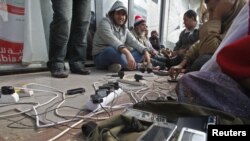The human rights organization WITNESS, founded by musician Peter Gabriel in 1992, was ahead of its time in recognizing the power of video to document human rights abuses. Founded in the days before the mass adoption of the Web, the organization cut its teeth arming and training human rights activists with video cameras.
Nearly 20 years later, video -- in particular video taken from cell-phone cameras -- has changed the game, not only in enabling activists to get their stories out to the outside world, but also in helping create public momentum and cohesion among those taking on their regimes.
A fascinating new WITNESS report, "Cameras Everywhere," looks at how the proliferation of cameras has enabled so many of us to bear witness, but also asks the hard questions "about how to protect and empower those who attempt to expose injustices through video."
Once activists were activists by choice; now, armed with cell phones, more and more people than ever before have the potential to document rights abuses. That's all good: It has allowed the world to see atrocities that would normally have been hidden from prying eyes and has helped fuel the revolutions engulfing the Arab World. But with all those new opportunities and rewards, there are risks.
As the report notes, one of the biggest downsides of the democratization of bearing witness is the "safety and security of those filming and of those being filmed":
[T]he ease of copying, tagging, and circulating images over a variety of platforms adds a layer of risk beyond an individual user's control. All content and communications, including visual media, leave personal digital traces that third parties can harvest, link, and exploit. The authors argue that their safety will need to be considered "at each stage of video production and distribution.
With cameras everywhere, there is a much greater chance of activists being recognized, for example in footage from protests. After the postelection violence in Iran in 2009, the authorities set up websites to identify protesters, a tactic copied by websites in London following the riots this year. And sophisticated off-the-shelf facial-recognition technology is increasingly being used by repressive regimes. To help combat that, the report advocates more "visual anonymity," for example by getting hardware manufactures or video-sharing site operators to introduce face-blurring technologies to protect the identity of those filmed.
The report also touches on "intermediary censorship" -- where the existence and future posterity of human rights footage is at the mercy of companies like YouTube or Flickr. Graphic human rights content is often taken down by platforms like YouTube for violating their terms of service. "Video content is vulnerable to interception, takedown, and censorship, and needs active protection," according to the report. To name just one example, videos showing abuses of ethnic Uzbeks in Kyrgyzstan in June 2010 were quickly taken down after being flagged by other YouTube users.
Some progress has been made on this issue. In the last year or so, in particular after Arab Spring protests, companies like YouTube and Facebook are aware that they are being used as a platform for activists. There is at least now a healthy public discussion about the ethics of hosting or not hosting such content. As the report points out, when Iranians were uploading video in 2009 showing abuse by security forces against protesters, much of it was taken down by YouTube after being flagged. But since then, YouTube has relaxed its policy somewhat and allowed protesters to upload video.
One of the solutions offered by the report authors is for video- and photo-sharing websites to create human rights categories that will have more protection against arbitrary takedown. In principle this sounds like a good idea, but it does seem hard to police and possibly open to abuse: i.e. a skinhead group, posting under a different name, could upload footage of people with dark skin being beaten up. The footage could be simply tagged or titled as "human rights abuses." It would be hard for the platform to be able to assess the motivations for uploading content: is the purpose of the video to report abuses or spread hate?
The story of the Arab Spring has not just been one of activists, armed with digital tools, taking on their regimes, but it has also been a story of countermeasures: increasingly tech-savvy regimes fighting back against their citizens. As this op-ed in the "Los Angeles Times" points out, much of the focus of the U.S. Internet freedom program (and of course other non-U.S.-funded NGOs) "is on protection: tools and training that will enable democratic activists to use technology without endangering themselves and others." In terms of identifying the risks activists face and offering potential solutions for how to deal with them, "Cameras Everywhere" is required reading.




